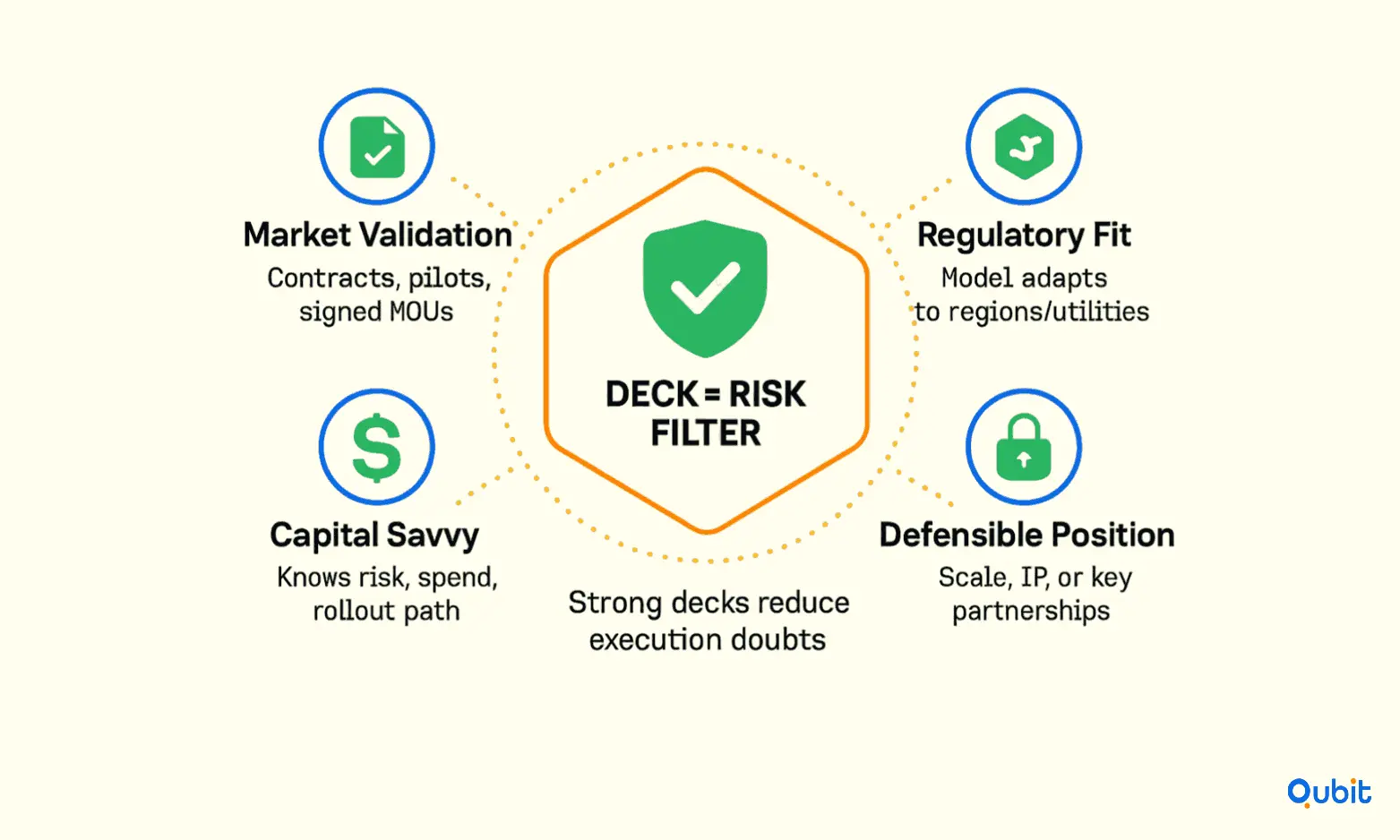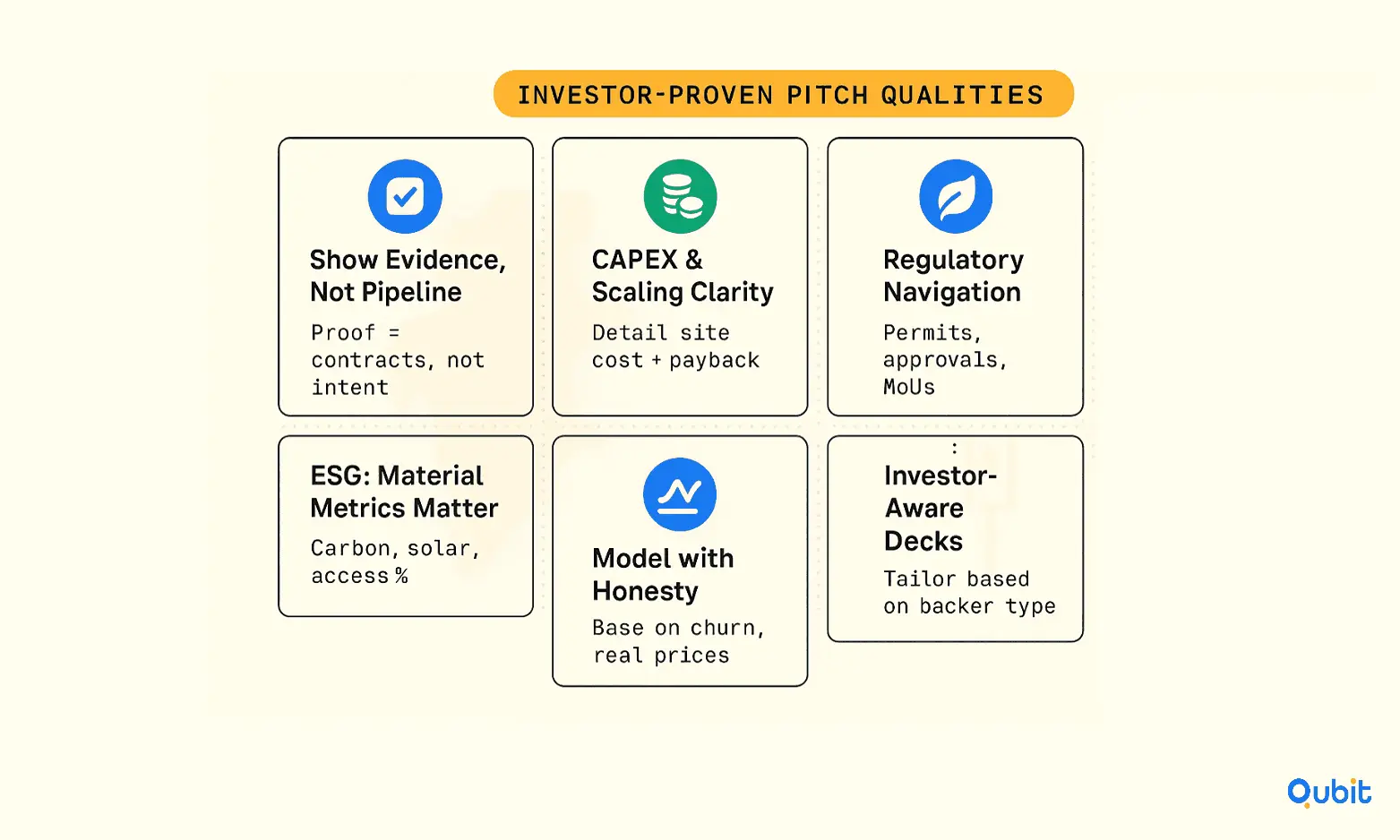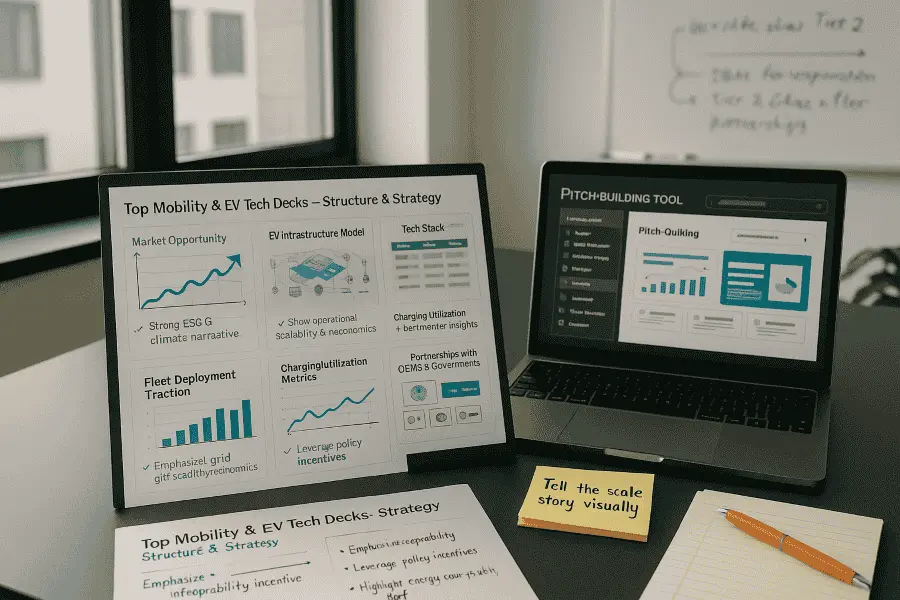Electric vehicles (EVs) and mobility startups are reshaping the transportation industry, but securing investor interest requires more than just a great idea. A compelling EV pitch deck is the cornerstone for communicating your vision, strategy, and growth potential. This document not only highlights your unique value proposition but also demonstrates how your startup fits into the broader mobility ecosystem.
Your review of mobility startup fundraising strategies clarifies how your pitch deck builds on a broader framework of financial planning and investor relations. By aligning your pitch with investor expectations, you can position your startup as a leader in EV innovation.
Let’s explore how a well-crafted pitch deck can unlock the full potential of EV, charging, and mobility tech startups.
Why Deck Disciplines Matter in EV/Mobility
Today’s investors see countless mobility and EV concepts but fund only teams with:

- Clear market validation (real contracts, deployments, or signed MOUs)
- Deep awareness of capital intensity and deployment risk
- A business model that survives regional regulation and utility complexity
- A defensible position—whether through technology, partnerships, government traction, or operational scale
A best-in-class deck doesn’t just present growth—it de-risks execution.
Mobility Business Startup
The mobility startup ecosystem is brimming with opportunities for entrepreneurs ready to innovate. With the global demand for efficient transportation solutions on the rise, this sector offers a fertile ground for scalable and impactful business models. From ride-hailing services to last-mile delivery platforms, mobility businesses are transforming how people and goods move across cities and countries.
Why Mobility Startups Are Thriving
Proven Scalability: Successful mobility businesses demonstrate their ability to handle high volumes. For instance, platforms achieving 50M+ rides showcase the potential for massive scalability and operational efficiency. This performance metric highlights the viability of high-demand models in the mobility space.
Global Expansion Potential: The mobility sector is not confined to local markets. Businesses in this space have successfully expanded to 75+ countries, proving that geographic boundaries are no barrier to growth. This global reach underscores the adaptability of mobility solutions to diverse markets and consumer needs.
Innovative Business Models: Mobility startups are at the forefront of innovation, introducing subscription-based services, electric vehicle (EV) fleets, and AI-driven route optimization. These advancements not only enhance user experience but also create sustainable and cost-effective solutions.
Growth Potential in Global Markets
The mobility business is uniquely positioned to tap into the growing urbanization and digital transformation trends worldwide. As cities become smarter and more connected, the demand for efficient, tech-driven mobility solutions will only increase. Entrepreneurs entering this space can capitalize on this momentum by focusing on customer-centric and scalable models.
Whether you're looking to launch a ride-hailing app, a micro-mobility service, or a logistics platform, the mobility sector offers endless possibilities for growth and innovation.
Pitch Deck: Importance & Elements
Crafting a compelling pitch deck is a cornerstone of startup success, especially in competitive industries like mobility and electric vehicles (EVs). A well-structured deck not only captures investor attention but also communicates your vision with clarity and confidence. This section explores the essential elements that make up an effective pitch deck, ensuring your presentation resonates with potential investors.
Problem Definition
Start by defining the problem your startup aims to solve. Investors need to understand the pain points in the market and why they matter. For example, Uber's Seed Funding Pitch Deck highlighted inefficiencies in traditional taxi services, such as lack of GPS tracking and driver coordination. This clear articulation of the problem helped Uber secure $200K in seed funding and expand to over 900 cities. Similarly, your pitch deck should pinpoint the challenges your solution addresses, backed by real-world data or customer testimonials.
Solution Articulation
Once the problem is established, present your solution as the logical answer. This section should emphasize innovation and practicality. For mobility startups, integrating tech-driven platforms or EV solutions can be a game-changer. Use visuals, prototypes, or case studies to demonstrate how your solution works.
Market Opportunity
Highlighting market opportunity is crucial to proving your startup’s scalability. Investors want to see the size of the market, growth potential, and target demographics. Include statistics and projections that validate your claims. For EV pitch decks, this might involve showcasing the rapid adoption of electric vehicles and the increasing demand for sustainable mobility solutions.
Fleet Utilization
For mobility startups, fleet utilization is a key metric that demonstrates operational efficiency. Investors will want to know how your business optimizes resources, reduces downtime, and maximizes profitability. Incorporate charts or graphs to illustrate fleet performance and utilization rates.
Revenue Models
Revenue models are the backbone of any pitch deck. Clearly outline how your startup generates income, whether through subscription plans, pay-per-use models, or partnerships. Ensure this section is concise yet detailed enough to instill confidence in your financial strategy.
Sustainability Initiatives
Sustainability is increasingly becoming a priority for investors, especially in the EV and mobility sectors. Highlight your commitment to eco-friendly practices, such as reducing carbon emissions or utilizing renewable energy sources. This not only aligns with global trends but also positions your startup as socially responsible.
Financial Projections
Financial projections are where you demonstrate the viability of your business. Include realistic forecasts for revenue, expenses, and profit margins over the next 3–5 years. Use charts and tables to make this data digestible. Ensure your projections align with your revenue model and market opportunity.
Funding Ask Specifics
End your pitch deck with a clear funding ask. Specify the amount you’re seeking, how it will be allocated, and the expected outcomes. Be transparent and precise, as this builds trust and credibility.
By combining strategic storytelling with hard data, your pitch deck can become a powerful tool for securing investor confidence.
Sector-Specific Best Practices for Your Deck

a) Show Real-World Evidence, Not Just Plans
- Investors want to see signed contracts, pilot completions, or booked revenue, not just “pipeline” or “intent.”
b) Be Transparent About CAPEX and Scaling Risk
- Break out not just total capital, but site-level costs, expected utilization, payback periods, and OPEX over time.
c) Detail Regulatory and Policy Navigation
- Highlight pre-approved permits, compliance checks, or MoUs with authorities, especially if in a market with city/state complexity.
d) ESG & Impact Are Not Window-Dressing
- ESG metrics (carbon saved, accessible sites, percent solar/grid integration) increasingly drive both grant access and late-stage fund returns.
e) Financial Model: Clarity and Honesty
- Avoid over-inflated size or margin promises. Back forecasts with market-typical utilization, churn rates, and pricing. Include downside/probabilistic scenarios.
f) Tailor Deck for Investor Audience
- If pitching government, lead with public impact and compliance.
- For VCs, show returns, scaling path, data defensibility.
- For corporates/utilities, emphasize partner integration, grid-stability, and joint go-to-market.
Example Benchmarks & KPIs (as of 2025)
| Metric | What Success Looks Like | Why Important |
|---|---|---|
| Station/Uptime | >95% | Reliability & repeat use |
| Utilization Rate | 20–30% (high), 10% (average) | Payback, revenue projection |
| Payback Period | <4 years per site (urban) | ROI/IRR, needed for scale |
| Customer Growth | 30%+ QoQ in early markets | Market adoption/saturation speed |
| Regulatory/Permit Conversion | 3–6 months/site (best) | Scalability, avoids delays |
| Carbon/Energy Mix | >40% renewable grid or offset | ESG, policy, green finance access |
Electric Mobility Pitch Deck
Crafting a compelling pitch deck is essential for electric mobility startups aiming to secure funding and partnerships. A well-designed presentation not only highlights innovative solutions but also communicates the startup’s vision for sustainable transportation. This section explores tailored templates, creative slide designs, and strategic approaches to showcase key aspects like charging infrastructure and electrification trends.
Designing for Impact
Startups in the electric mobility space must prioritize clarity and visual appeal in their pitch decks. Incorporating concise messaging, data-driven visuals, and bold designs ensures that investors and stakeholders grasp the potential of the business quickly. Templates specifically designed for EV startups can streamline this process, offering pre-built layouts that emphasize critical elements such as market opportunity, technology differentiation, and scalability.
Highlighting Electrification Trends
The transition of ride-hailing and bike-sharing fleets to electric vehicles is a prime example of electrification dominance. This trend not only reduces emissions but also aligns with global sustainability goals. Discussing the impact of growing EV fleets under the electrification dominance trend can strengthen your pitch, showcasing how your startup contributes to this transformative shift.
Charging Infrastructure Strategies
A robust charging infrastructure is vital for the success of electric mobility solutions. When presenting this aspect, focus on innovative approaches to deployment, scalability, and accessibility. The section on pitch investors EV charging shows you how targeted strategies for EV initiatives integrate into your overall presentation narrative. By addressing infrastructure challenges and solutions, your pitch deck can demonstrate foresight and preparedness, key factors for investor confidence.
Strategic Tips for Success
- Start with a Vision Statement: Begin your pitch deck with a compelling vision for the future of electric mobility. This sets the tone and engages your audience from the outset.
- Use Data to Build Credibility: Incorporate statistics and projections to validate your claims, whether it’s market growth or environmental impact.
- Focus on Scalability: Highlight how your solutions can expand to meet growing demand, ensuring long-term viability.
- Keep Slides Concise: Avoid overcrowding slides with text; instead, use visuals and bullet points to convey information effectively.
By combining innovative slide designs, strategic insights, and a clear narrative, electric mobility startups can create pitch decks that resonate with investors and stakeholders alike.
Conclusion
Crafting the best practice pitch decks for EV and mobility tech startups requires a strategic blend of clarity, precision, and innovation. By focusing on data-driven insights, presenting clear financial projections, and highlighting sustainability initiatives, startups can create compelling narratives that resonate with investors. These elements not only showcase the potential of your venture but also establish credibility and trust.
Remember, a well-structured pitch deck tailored to the unique demands of the EV sector can make all the difference in securing funding. If you're aiming to connect with the right investors, we at Qubit Capital are here to support your investor outreach efforts. Start your journey with us today.
Key Takeaways
- A data-driven pitch deck is essential for securing EV infrastructure investments.
- Clear revenue models and financial projections significantly boost investor confidence.
- Customizable slide decks allow for tailored presentations that resonate with investors.
- Real-world case studies validate strategic pitch decisions.
- Incorporating sustainability and government incentives differentiates your pitch.
Frequently asked Questions
What should be included in a mobility startup pitch deck?
A well-structured pitch deck for a mobility startup should highlight key elements such as a clear problem statement paired with an innovative solution overview. It should also include market analysis, financial projections, and operational metrics like fleet utilization and sustainability initiatives. Conclude with a concise ask and a defined use of funds to ensure clarity for potential investors.






